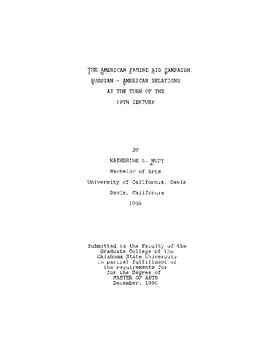| dc.description.abstract | There are two distinct schools of thought on exactly when the United State and Russ1a "met" and their previously friendly relationship began to deteriorate. The first, held by advocates of ideological causation, argues that this deterioration began when Americans, led by George Kennan, first became aware of large ideological discrepancies between the two nations in the 1870s and 1880s. The second theory argues that such antagonism did not begin until the early 1900s, as Russian and American economic interests began to clash in Asia. The thesis that follows illustrates that, rather than being in conflict, these two motivations, economic and ideological, came together forcefully at the turn of the nineteenth century. This union of forces centers around a seemingly minor event in the wider flow of fin-de-siecle international relations: the American Relief Campaign during the Russian famine of 1892. Initially. this philanthropic movement iii appears to be an interesting, albeit insignificant, episode in Russian-American relations that has been overshadowed by larger relief movements during the 1920s. However, continued exploration of American and Russian relations during the 1890s indicates that this movement played a much larger role. The Famine Aid Campaign. begun as a scheme to increase American wheat exportation. was a pivotal point from which a change in American perceptions of Russians evolved. Prior to the famine, most Americans tended to view the Russian government uncritically, as a friend and ally; after the Aid Campaign this perception had changed. Americans increasingly viewed the Tsarist government as a tyranny, victimizing defenseless peasants. This change in perceptions ultimately evolved into a transformation of U.S. foreign policy. This thesis explores the relationship between economics, ideology, and foreign policy during the late nineteenth century. It is an examination of the American relief effort in terms of both the economic and political factors from which the movement arose, and the changes that resulted from it. Viewed in this manner, the famine becomes, not simply an isolated case of crop failure, but a "sign post" for change. It marked the end of Russian hegemony in the European wheat market and the beginnings of the Russian struggle to industrialize. Similarly, the American relief program, in addition to illustrating the new kind of "business" thinking that was developing in America, marked the beginning of a shift in American-Russia relations. | |
